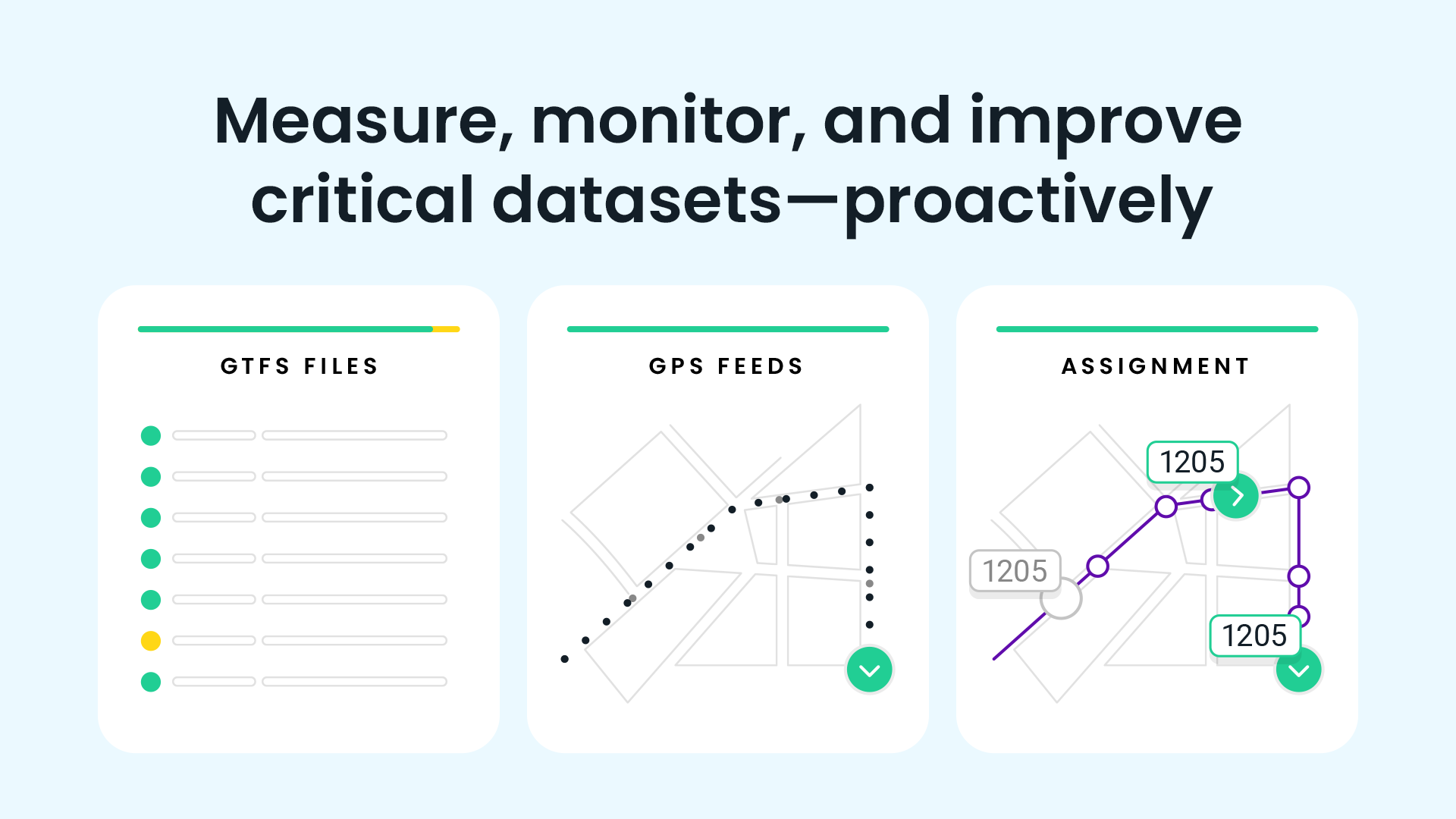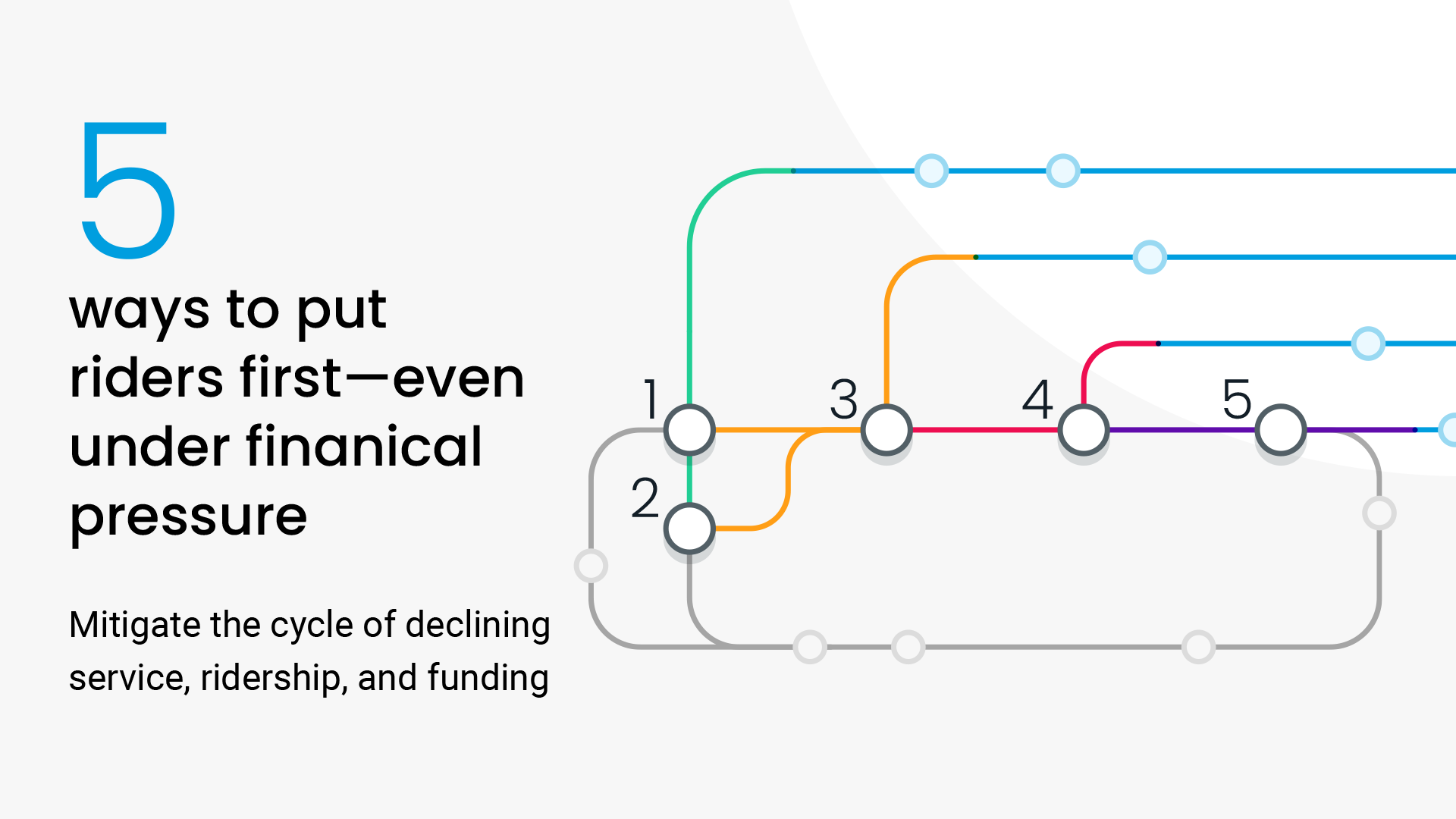
January 10, 2023
Introducing Headsign Connector: Reliable headsigns at last

January 10, 2023
Introducing Headsign Connector: Reliable headsigns at last
January 10, 2023
Introducing Headsign Connector: Reliable headsigns at last
Headsigns: A window into your transit data
In many ways, the humble bus headsign is the unsung hero of public transit. Not only are headsigns among the most looked-at parts of your entire transit fleet; they’re also a critical, effective, and elegant means of making public transit intuitive and attractive to passengers. Despite headsigns’ importance, transit agencies often miss the opportunity to make the most of this prime real estate. Headsigns commonly show the wrong information, creating headaches for agency staff and putting trust into jeopardy for passengers.
That's why we're excited to introduce Headsign Connector, a new product that tackles headsign inaccuracies and time consuming processes to give the humble headsign the respect it deserves. Headsign Connector is the first solution to use routers, rather than expensive CAD/AVL VLUs to power headsigns with reliable, real-time headsign information. This is the latest addition to Swiftly Connected Transit Platform's capabilities to connect transit data with best-in-class hardware.
Headsign Connector solves issues stemming from CAD/AVL systems and human error
Headsign Connector aims to solve the two most common causes of headsign malfunctions: CAD/AVL integrations and human error. Headsigns receive data from one of two sources, a CAD/AVL system or a headsign keypad, both of which are error-prone and difficult to maintain.
For agencies with CAD/AVL integrations, headsigns are only as accurate as the CAD/AVL vendor’s underlying understanding of where a vehicle is and will be next which depends on schedule and assignment data. This understanding is commonly inaccurate when it comes to more complex situations like interlining, real-time adjustments to service, and transitions in and out of service. Sean O'Leary, Director of Operations at Transit Authority of Northern Kentucky (TANK) describes, “For the longest time, our headsigns just didn’t work. Our headsigns are supposed to integrate with our CAD/AVL and update automatically. But our headsigns just didn’t work when connected to our CAD/AVL system.” The result is that passengers see incorrect information that can affect which bus they board.
Headsign Connector relies on Swiftly’s data engine, so headsigns will always show highly accurate data that takes into account changes to service, interlining, and other complex situations. This standalone solution doesn’t require an expensive VLU or CAD/AVL system. It works with headsigns and routers agencies have already purchased, enabling agencies to get up and running quickly.
For agencies without a CAD/AVL integration, bus operators must set headsign information before every trip via a small keypad-based interface. Operators often forget to set a heading or enter the incorrect route code. Sometimes, the keypad buttons are very hard to push and out of reach, leading some operators to bring sticks onboard to push the above head buttons.
According to Sean O'Leary, Director of Operations at TANK, “managing a headsign is one more task for our operators during an already stressful job. Some operators carried around long wooden dowels just to reach the buttons. Imagine, in 2022 our operators were literally using wooden sticks to do their job.” All of these processes are time consuming, distracting and are safety risks.
With Headsign Connector, headsigns change automatically, allowing operators to focus on operating their vehicle.
How Headsign Connector works
Headsign Connector works by connecting headsigns directly to Swiftly’s data engine through an onboard router, such as Sierra Wireless or Cradlepoint routers. A Swiftly app on the router receives real-time headsign information from Swiftly’s data engine with each vehicle’s assignment data. New headsign files can be uploaded over-the-air in less than a second, meaning agencies don’t need to pull vehicles out of service or do updates at night. Headsign Connector gives agencies the ability to view what headsigns are displaying in Live Operations, so customer service and operations can see the same information as passengers. With Headsign Connector, agencies can feel confident in the information they’re providing passengers and the time savings for staff.
Request a demo
Common use cases and benefits of Headsign Connector
For passengers:
With Headsign Connector, passengers can view Swiftly’s industry-leading data engine in the accuracy of the headsigns. Passengers know they can rely on the information to tell them where their bus is headed.
For operations:
With Headsign Connector, operations can feel confident in headsign accuracy without any operator interaction. By viewing headsign information from Live Operations, dispatchers can check accuracy at any point in time remotely. Operations can rest easy knowing that operators don’t need to juggle driving a bus with punching in codes or risk making an error that confuses passengers.
“Our operators are very happy with the changes. It’s one less thing for them to worry about. Happier operators are better operators. Headsign Connector means one less stressor for our operators, and every bit of eliminated stress helps. From a risk and liability standpoint, it’s tremendous, too. Our operators don't have to take their eyes off the road to change the headsign. They can focus on the thousand other things requiring their attention.”
—Sean O'Leary, Director of Operations at TANK
For maintenance:
Beyond managing the adjustments of headsigns during service, agencies also need control over the database of headsign codes. For most agencies, this is a challenge that often requires bringing a flash drive to each bus, or waiting an extended period for a slow serial connection. This is particularly challenging because there’s often no good time for the buses to be out of service for the updates to happen.With Headsign Connector, maintenance doesn’t need to worry about changing out headsign codes in the middle of the night with a thumbdrive. Instead, they can upload new codes anytime, over-the-air, without any downtime.
For leadership:
With Headsign Connector, transit agency leadership knows they’re bringing passengers the industry’s best information while saving staff time and reducing safety risks. Leaders are excited about the opportunity to move away from expensive VLUs and connect with hardware through routers they've already purchased.
Customers are already seeing proof of the more reliable information. O'Leary shared, “we haven’t gotten a single headsign-related complaint about our connected buses since we rolled out Headsign Connector.”
Reliable headsigns at last!
Headsigns are one of the most visible ways passengers understand their transit service. With Headsign Connector, we’re making sure they’re reliable and easy to maintain.
Want to see how Headsign Connector could work at your agency? Reach out for an in-depth demo.
The rich text element allows you to create and format headings, paragraphs, blockquotes, images, and video all in one place instead of having to add and format them individually. Just double-click and easily create content.
Last Name, Agency

What’s a Rich Text element?
What’s a Rich Text element?
What’s a Rich Text element?
What’s a Rich Text element?
What’s a Rich Text element?
The rich text element allows you to create and format headings, paragraphs, blockquotes, images, and video all in one place instead of having to add and format them individually. Just double-click and easily create content.
Last Name, Agency
Static and dynamic content editing
A rich text element can be used with static or dynamic content. For static content, just drop it into any page and begin editing. For dynamic content, add a rich text field to any collection and then connect a rich text element to that field in the settings panel. Voila!
How to customize formatting for each rich text
Headings, paragraphs, blockquotes, figures, images, and figure captions can all be styled after a class is added to the rich text element using the "When inside of" nested selector system.
- text goes here
- text goes here
- text goes here
- text goes here
- text goes here
- text goes here









